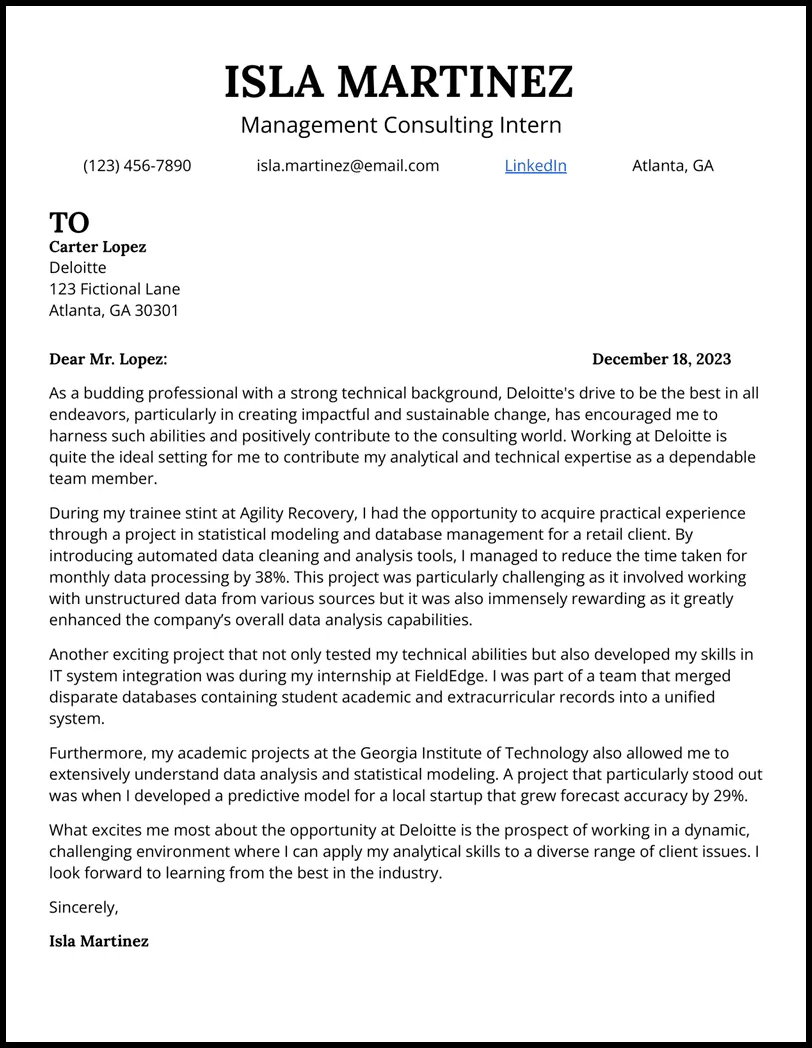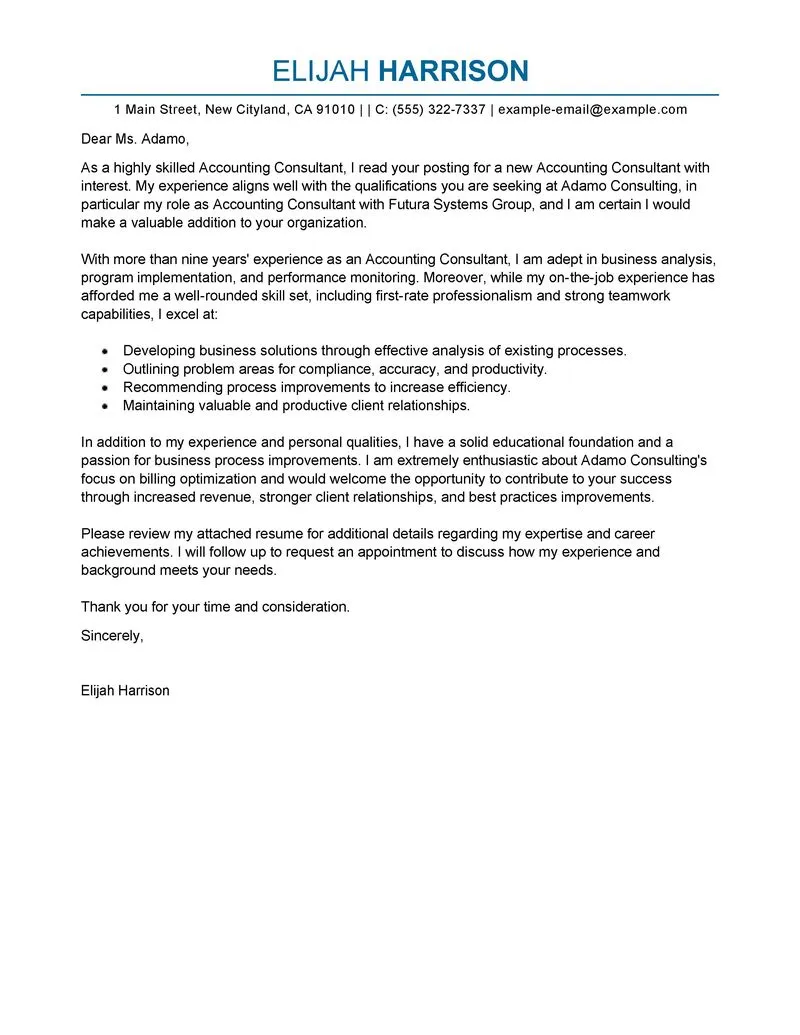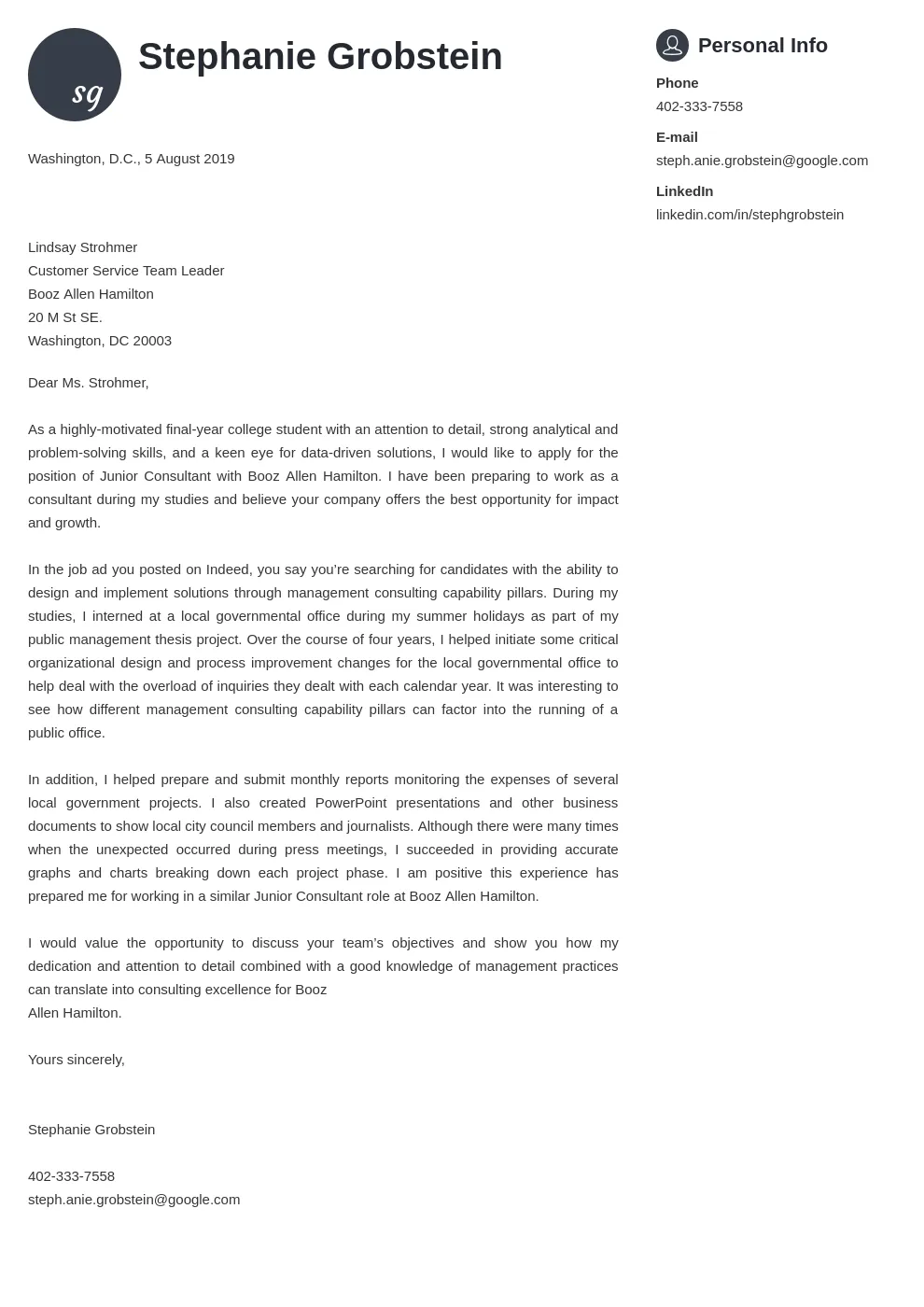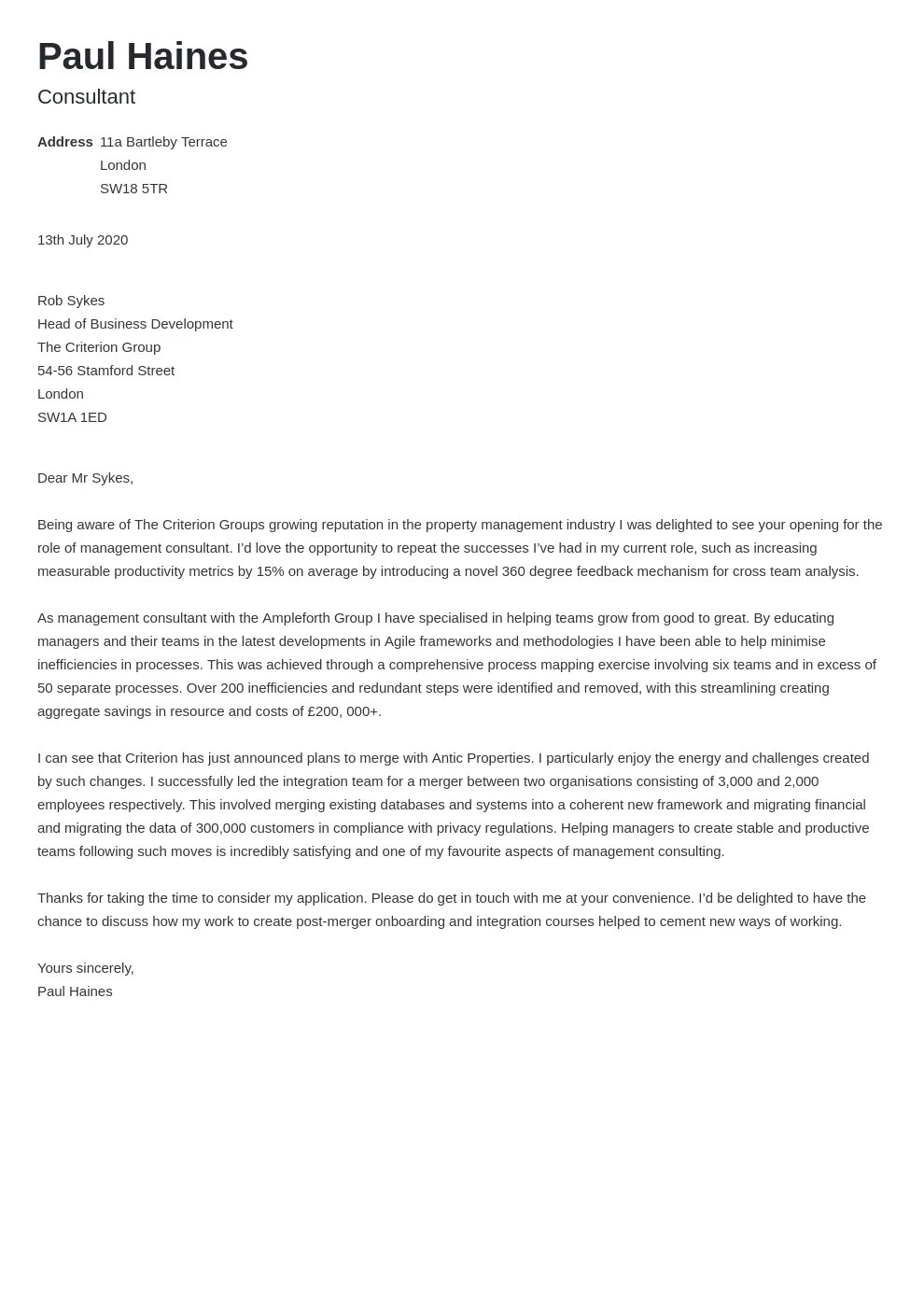Understanding the Consulting Cover Letter
A consulting cover letter is your first opportunity to make a strong impression on potential employers. It’s a crucial document that accompanies your resume, providing a personalized introduction and highlighting your qualifications. Unlike a generic resume, the cover letter allows you to explain why you’re the ideal candidate for a specific consulting position. It offers a platform to showcase your personality, demonstrate your understanding of the firm, and express your enthusiasm for the opportunity. The cover letter shouldn’t just repeat information from your resume; instead, it should expand on your key skills and experiences, illustrating how they align with the needs of the consulting firm. It is also an opportunity to make yourself stand out from other candidates, emphasizing your unique selling points and demonstrating your understanding of the consulting world.
Key Components of a Consulting Cover Letter
A well-structured consulting cover letter typically includes several key components. Begin with a professional heading that includes your contact information and the date. Next, address the hiring manager or the specific contact person if known; if not, use a generic, but respectful greeting like “Dear Hiring Manager.” The introduction should immediately grab the reader’s attention, stating the position you are applying for and how you learned about it. The body of the letter is where you demonstrate your value by highlighting relevant skills, experiences, and accomplishments. This should be tailored to the specific requirements of the job description. In the closing paragraph, reiterate your interest, express your enthusiasm, and provide a call to action, such as requesting an interview. Conclude with a professional closing like “Sincerely” or “Best regards,” followed by your full name.
Highlighting Relevant Skills and Experience

When crafting your consulting cover letter, it’s crucial to highlight the skills and experiences that are most relevant to the position. Begin by carefully reviewing the job description and identifying the key requirements. Then, select the experiences and skills from your background that directly address these requirements. Quantify your achievements whenever possible to demonstrate the impact you’ve made in previous roles. For example, instead of saying “Improved sales,” you could state “Increased sales by 15% within six months.” Focus on skills that are highly valued in consulting, such as problem-solving, analytical thinking, project management, communication, and teamwork. Use specific examples to illustrate how you’ve successfully applied these skills in the past. This helps the hiring manager quickly understand your capabilities and how you can contribute to their team. Furthermore, remember to align your skills and experience with the specific type of consulting the firm practices, for instance, strategic, financial, or operational consulting.
Tailoring Your Cover Letter to the Consulting Firm
One of the top secrets for a successful consulting cover letter is tailoring it to each specific firm. Generic cover letters rarely make a positive impression. Research the consulting firm thoroughly to understand its values, mission, and the types of projects it undertakes. Review the firm’s website, recent news articles, and any social media presence to gain insights. Use this information to personalize your cover letter. Mention specific projects the firm has worked on that resonate with your interests and skills. Address the letter to the appropriate person, usually a hiring manager or a specific contact. Show that you understand the firm’s culture and the challenges it faces. Demonstrate how your skills and experience can help the firm succeed. This level of personalization proves you’ve done your homework and are genuinely interested in joining the firm. Highlighting this level of effort shows you are not only interested but have an intrinsic motivation to solve their clients’ challenges.
Showcasing Your Problem-Solving Abilities
Problem-solving is at the heart of consulting. Your cover letter should explicitly demonstrate your problem-solving abilities. Provide examples from your past experiences where you have successfully identified, analyzed, and resolved complex problems. Use the STAR method (Situation, Task, Action, Result) to structure your examples. Describe the situation you faced, the task you were assigned, the actions you took to address the problem, and the positive results you achieved. For instance, you might describe how you identified inefficiencies in a process, designed a solution, implemented it, and as a result, improved productivity. When explaining your actions, emphasize your analytical skills, critical thinking, and ability to develop innovative solutions. Consulting firms want to see how you approach challenges, the tools you use, and the impact of your work. Highlighting these elements in your cover letter will showcase your value as a potential consultant.
Demonstrating Your Communication Skills

Effective communication is essential in consulting, and your cover letter is an opportunity to showcase these skills. Write clearly, concisely, and persuasively. Your cover letter should be free of grammatical errors and typos, demonstrating your attention to detail and professionalism. Use strong action verbs to describe your accomplishments and responsibilities. Tailor your language to the specific firm and the position, reflecting the tone and style of communication that’s expected. Beyond written communication, consider mentioning any experiences where you have presented to clients, led meetings, or facilitated discussions. These examples highlight your ability to convey complex information effectively, build rapport, and influence others. Make sure you show that you can articulate your thoughts clearly and professionally. Good communication is the cornerstone of successful client relationships in the consulting world.
Expressing Enthusiasm and Professionalism
Expressing genuine enthusiasm and maintaining professionalism are crucial in a consulting cover letter. Your enthusiasm should be evident throughout the letter, reflecting your passion for consulting and your interest in the specific firm. Demonstrate this enthusiasm by mentioning why you are drawn to the firm and the types of projects it undertakes. Explain what excites you about the opportunity. Maintain a professional tone throughout the letter. Use formal language, avoid slang or casual expressions, and adhere to proper business etiquette. Proofread your cover letter carefully to ensure there are no errors that could undermine your credibility. Present yourself as a polished, confident, and capable professional who is eager to contribute to the firm’s success. Showing enthusiasm and professionalism shows your eagerness to be part of the team and helps you make a lasting, positive impact.
Structuring Your Consulting Cover Letter Effectively
The structure of your consulting cover letter is critical for readability and impact. Begin with a strong introduction that captures the reader’s attention and clearly states the position you’re applying for. In the body paragraphs, focus on showcasing your key skills, experiences, and accomplishments. Each paragraph should address a specific point, making it easy for the hiring manager to grasp your qualifications quickly. Use bullet points or numbered lists to highlight your achievements or skills, making the information more scannable. Maintain a logical flow throughout the letter, connecting each point to the overall message. The structure must be easy to follow. The closing paragraph should reiterate your interest in the position, summarize your key strengths, and include a clear call to action, such as requesting an interview. A well-structured cover letter is easy to read and effectively communicates your value to the consulting firm. Using a clear structure is the best method to show you can bring structure to the firm’s work.
Formatting Your Cover Letter for Readability

Proper formatting enhances the readability and professional appearance of your consulting cover letter. Use a standard font, such as Times New Roman, Arial, or Calibri, in a readable size (11 or 12 points). Maintain consistent margins (typically 1 inch on all sides) and line spacing (usually 1.15 or 1.5). Use clear headings and subheadings to break up large blocks of text and guide the reader. Avoid using excessive bolding, italics, or underlining. Keep the layout clean and uncluttered, making it easy to scan and digest the information. Ensure that the formatting is consistent throughout the entire document. Before submitting your cover letter, review the formatting to ensure it aligns with the firm’s professional standards and is visually appealing. Make sure it looks good on any device; the last thing you need is the letter to be poorly formatted.
Proofreading and Editing Your Cover Letter
Thorough proofreading and editing are essential to create a flawless consulting cover letter. Errors can undermine your credibility and make you appear unprofessional. After writing your cover letter, carefully proofread it for any grammatical errors, spelling mistakes, punctuation issues, and typos. Read the letter aloud to catch any awkward phrasing or sentence structures. Consider having a friend, mentor, or career advisor review your cover letter to provide feedback and catch any mistakes you might have missed. Pay close attention to the clarity and conciseness of your writing. Ensure that your message is easy to understand and effectively conveys your qualifications. A well-proofread and edited cover letter demonstrates your attention to detail, which is a critical skill in consulting. Taking the time to proofread ensures the letter reflects well on your abilities and helps you make a strong first impression. Make sure the final copy is the best representation of your abilities.
